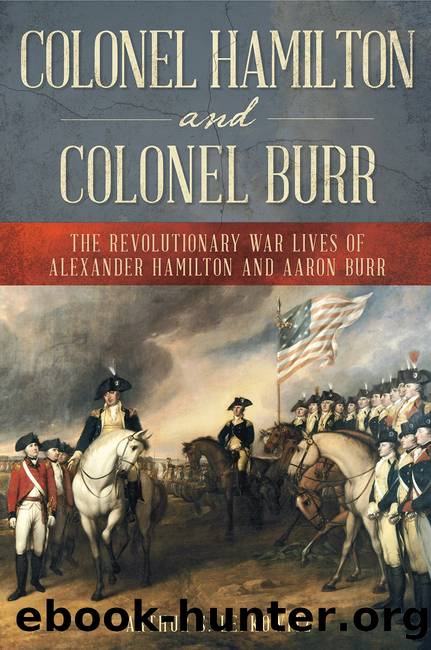Colonel Hamilton and Colonel Burr by Arthur S. Lefkowitz

Author:Arthur S. Lefkowitz
Language: eng
Format: epub
Publisher: Stackpole Books
Published: 2020-08-28T00:00:00+00:00
The events leading to the establishment of Malcolmâs Regiment began in late December 1776 when the Continental Congress authorized Washington to raise sixteen additional regiments for the Continental Army. The wording of their instructions to Washington is important, as Congress allowed him to personally appoint the officers for the sixteen new regiments. The pertinent text of Congressâ instructions reads, âThat General Washington shall be, and he is hereby, vested with full, ample, and complete powers to raise . . . from any or all of these United States, 16 battalions of infantry and to appoint officers for the said battalions.â54 According to the 1779 An Universal Military Dictionary, a battalion is a body of infantry generally from five hundred to eight hundred men. The Americans used the word battalion loosely early in the Revolution to mean the same thing as a regiment.
Washington gave command to one of the sixteen new regiments to William Malcolm, a wealthy New York merchant and militia colonel. Malcolmâs appointment was due in part to his providing the money to outfit the regiment and offering bounties for men to join it. The regiment was organized on April 30, 1777, and named in Malcolmâs honor. It appears in the records of the Revolution as Malcolmâs Additional Regiment. Washington realized that Colonel Malcolm had little military experience and needed an experienced officer as his second in command. Washington picked Burr who, as the regimentâs lieutenant colonel, actually commanded the regiment in the field and led it in combat. Burr was twenty-one years old at the time of his appointment. He has the distinction of being the youngest person to be appointed to the rank of lieutenant colonel in the Continental Army during the Revolutionary War. Burr was probably appointed by Washington based on a recommendation he received from William Livingston, the governor of New Jersey. Livingston was one of Washingtonâs most important supporters, and his suggestions were taken seriously. Writing to Washington on February 15, 1777, Governor Livingston said, âMay I once more take the liberty to mention to your Excellency Major Burr aid de Camp to General Putnam? I think him a most promising youth & like to do Honour to his Country.â55 Besides Livingstonâs recommendation, while Washington may not have approved of Burrâs personal traits, he knew him to be a competent and courageous officer.
Washington replied to Governor Livingstonâs letter on February 22, 1777, saying, âI will most assuredly keep Mr. Burr in remembrance, and take the first proper Opportunity of giving him a more permanent Office than the one he now holds.â The reference to âa more permanent Officeâ is an acknowledgment by Washington that Burrâs present rank of major was a brevet position that he held only while he was an aide-de-camp to
Download
This site does not store any files on its server. We only index and link to content provided by other sites. Please contact the content providers to delete copyright contents if any and email us, we'll remove relevant links or contents immediately.
| Africa | Americas |
| Arctic & Antarctica | Asia |
| Australia & Oceania | Europe |
| Middle East | Russia |
| United States | World |
| Ancient Civilizations | Military |
| Historical Study & Educational Resources |
Magic and Divination in Early Islam by Emilie Savage-Smith;(1452)
Ambition and Desire: The Dangerous Life of Josephine Bonaparte by Kate Williams(1276)
Papillon by Henry Charrière(1260)
Bohemians, Bootleggers, Flappers, and Swells: The Best of Early Vanity Fair by Bohemians Bootleggers Flappers & Swells- The Best of Early Vanity Fair (epub)(1257)
Twelve Caesars by Mary Beard(1136)
Operation Vengeance: The Astonishing Aerial Ambush That Changed World War II by Dan Hampton(1110)
What Really Happened: The Death of Hitler by Robert J. Hutchinson(1066)
London in the Twentieth Century by Jerry White(1049)
Time of the Magicians by Wolfram Eilenberger(1027)
Twilight of the Gods by Ian W. Toll(1022)
The Japanese by Christopher Harding(1018)
Lenin: A Biography by Robert Service(981)
The Devil You Know by Charles M. Blow(931)
Freemasons for Dummies by Hodapp Christopher;(889)
A Social History of the Media by Peter Burke & Peter Burke(883)
Napolean Hill Collection by Napoleon Hill(860)
The Churchill Complex by Ian Buruma(857)
The Rise and Triumph of the Modern Self by Unknown(852)
Henry III by David Carpenter;(849)
